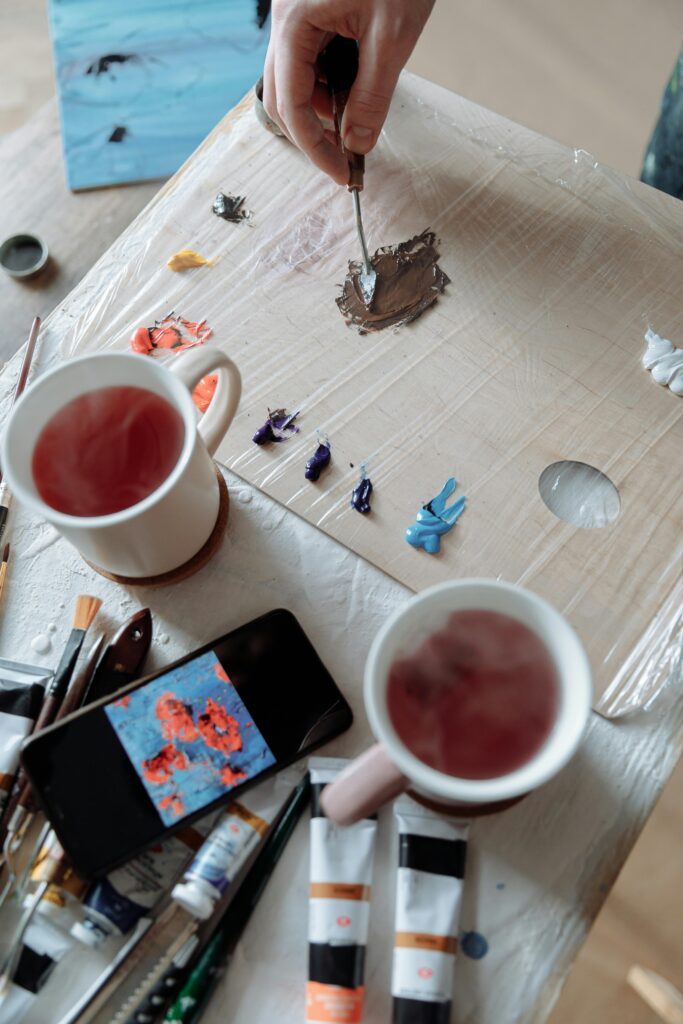How Teaching Can Be Your Side Business

Making ends meet as a new artist isn’t easy, and anyone who’s tried it knows the mix of excitement and uncertainty it brings. Some months feel full of promise, others feel like you’re stretching every penny just to keep creating. That’s why having a side hustle can be such a relief, not just financially but mentally too. Teaching is one of those rare side paths that actually complements your art practice instead of competing with it. You get to share your skills, stay connected to your craft, and bring in some steady income while doing something meaningful. It’s a smart, grounded way to support your creativity without losing sight of why you started in the first place.
And guess what? A 2023 survey found that over 70% of employers now expect some kind of portfolio in the hiring process. That’s no small number.
Having a folder of random lesson plans and student work isn’t enough. What hiring committees really want is a collection that tells a clear story: who you are as a teacher, what your style looks like in action, and why students thrive under your guidance. It’s not about stuffing everything you’ve ever done inside, it’s about curating the right pieces.
And as an art educator, you actually have a secret advantage. Unlike other subjects that might lean heavy on test scores and rubrics, your portfolio can be visual, vibrant, and alive. Imagine including photos of classroom setups, snapshots of student projects mid-process, or even reflective notes from learners about how a certain project made them think differently. That’s the kind of thing that turns a dry binder into a living story.
The shift to digital portfolios has only made this easier. A well-built online portfolio lets you go beyond text and paper , you can drop in video clips of lessons, interactive slides, or even walk-throughs of projects. Plus, it quietly tells the hiring team you’re organized, comfortable with tech, and know how to communicate visually. In today’s world, that matters.
So if the words “teaching portfolio” make you picture endless scanning and stapling, don’t panic. What you’re really building is a highlight reel , a carefully chosen, thoughtfully presented collection that says, “Here’s what I do, here’s how I do it, and here’s why it works.” By the end of this guide, you’ll know exactly how to put one together that feels authentic and makes hiring committees actually excited to learn more about you.

Your Teaching Portfolio Is Basically Your Stage Costume
If you’re stepping into the world of education, your teaching portfolio is the outfit you wear on stage. Not literally sequins and glitter, but the polished version of who you are as an educator and artist. People think it’s just about dropping a few lesson plans into a folder. Nope. It’s about curating your skills so someone else can picture you walking into a classroom and owning it.
Think of it this way: a director won’t cast an actor who shows up in pajamas to an audition, no matter how good they are. Similarly, a school or program won’t bet on you if your portfolio looks half-baked. The content is important, sure, but so is the presentation. That’s what shows you’re serious.
And let’s be honest, most of us have been guilty of throwing things together at the last minute. The problem? Reviewers can smell that. They want to see effort, consistency, and a little bit of your personality woven in. Your portfolio doesn’t just say “I can teach,” it says “I know how to organize, I know how to communicate, and I know how to inspire.”
The best part is, you get to decide what vibe you want it to give off. Do you want to come across as the fun, energetic teacher who makes learning feel like playtime? Or the thoughtful mentor who creates calm, focused environments? Your portfolio can signal that, just like a stage costume sets the tone before the first line is spoken.
So, before you even start adding files and lesson samples, ask yourself: what kind of role am I auditioning for? What impression do I want to leave behind? Answering that upfront can save you from creating something that looks generic and flat. Because trust me, nobody remembers a bland audition.
When you look at your portfolio as a performance in itself, you stop treating it like homework and start treating it like an opportunity. That little shift alone can set you apart from the dozens of other applications sitting in the same pile.
Lesson Plans Are Great, But Where’s Your Magic Trick?
Every teacher applicant includes a couple of lesson plans. That’s like bringing water to a picnic , useful, but not exciting. What really makes reviewers sit up straighter is when you add your “magic trick,” the unique twist you bring to teaching that nobody else does.
This could be a creative exercise you invented that got even the most distracted students engaged. Or maybe it’s the way you integrate art history into studio practice, making it feel alive rather than dusty. Your magic trick is that secret sauce that turns a good class into a memorable one.
The catch is, you can’t just say you have it, you’ve got to show it. Did your approach lead to students creating something surprising? Did you track improvement over time? Did you get feedback that made you realize your method worked? That’s the kind of proof that turns a claim into a highlight.
And don’t be afraid to showcase it visually. A picture of student work, a chart showing progress, even a short anecdote can make it real. Because in the end, a portfolio isn’t about promising potential, it’s about demonstrating it.
Think about how refreshing it would be for a hiring committee to flip through dozens of identical plans and suddenly see something that feels alive. That’s you. That’s your “ta-da” moment.
So, when you sit down to assemble your portfolio, don’t stop at the basics. Ask yourself: what’s the little spark that makes me different, and how can I make it impossible to miss?
Show the Teacher, Not Just the Artist
This one’s tricky for creatives. We love showing our art because it feels natural, but a teaching portfolio isn’t just about proving you can draw, paint, or sculpt. It’s about proving you can teach. And that means evidence of how you guide, not just what you create.
Sure, include your artwork , it shows your credibility. But make space for materials that reveal your teaching brain: syllabi, feedback forms, student reflections, even screenshots of slides you’ve used. Those things might not feel as glamorous as your portfolio piece, but they tell reviewers how you function in the classroom.
Think of it like applying for a chef position. The restaurant doesn’t just want to taste your cooking, they want to see you handle a kitchen, organize a menu, and train a team. Being a great cook doesn’t automatically make you a great teacher, just like being a strong artist doesn’t mean you can run a classroom.
And here’s the bonus: showing your teaching process can make you stand out even more. While most applicants lean heavily on their art, you can balance both worlds and prove you’re already thinking like an educator. That’s rare and powerful.
If you’ve ever mentored someone, run a workshop, or guided a peer through a technique, bring that in. Those micro-moments are gold because they show how you translate skill into learning.
At the end of the day, your portfolio should scream: “I’m not only talented, I know how to pass that talent on.” That’s the quality schools and programs want most.

Organized Chaos Doesn’t Count as Organized
Let’s talk about something unglamorous but game-changing: organization. You can have the best content in the world, but if your portfolio feels like a junk drawer, you’re sunk. Reviewers don’t want to hunt for things, they want a clean map.
Too many artists treat their teaching portfolios like personal scrapbooks. They stuff everything in there, from random sketches to old handouts, hoping more equals better. The truth? It just overwhelms people. Less is more, as long as “less” is purposeful.
Think of it like curating an exhibition. You wouldn’t hang 50 paintings in one room because no one would know where to look. You’d pick a few that speak together and let them breathe. Your portfolio deserves the same treatment.
That means clear sections, labels, and flow. Start with an introduction, move into teaching samples, sprinkle in student results, and end with a tidy CV. That rhythm alone can make your portfolio stand out because it shows you know how to structure information.
Here’s the kicker: organization also demonstrates how you’ll run a classroom. If you can’t put a portfolio together neatly, how will you manage a semester’s worth of lesson plans? Hiring committees notice these things, even if they never say it out loud.
So, take the time to edit ruthlessly. Cut what doesn’t add value, streamline what’s left, and present it in a way that feels easy to navigate. Your future self will thank you when your portfolio starts doing the heavy lifting for you.
Student Work Speaks Louder Than Recommendations
A glowing recommendation letter is great, but let’s be honest, they all start sounding the same after a while. What really cuts through the noise is student work. It’s living proof of how you teach and what kind of outcomes your methods deliver.
If you can, showcase before-and-after examples, group projects, or even snapshots of final exhibitions from your students. Those visuals tell a story no letter ever could. They say, “this person doesn’t just talk about teaching, they create results.”
And don’t stress if your students weren’t producing masterpieces. What matters is growth, engagement, and creativity. A simple exercise that unlocked imagination can look just as powerful as a polished final piece.
You might even consider adding short student reflections or anonymous quotes. Something as simple as “I never thought I could draw until this class” carries more emotional weight than a formal statement.
Think of it this way: when someone sees student work in your portfolio, they’re not just seeing art, they’re seeing evidence of your impact. That’s what makes you valuable.
So, as you gather material, don’t just focus on what you’ve done. Ask: what did my students achieve because of me? That’s the part that makes decision-makers lean in closer.
Digital Doesn’t Mean Dull
If you’re submitting your portfolio digitally (which is almost always the case now), don’t let it fall flat. A PDF doesn’t have to feel lifeless. In fact, your design choices can whisper little hints about who you are as a teacher.
Fonts, colors, and layouts matter more than you think. They don’t need to be wild or overdesigned, but they should reflect clarity and creativity. Think clean, think professional, but also think you. Your portfolio is a chance to show you can blend structure with personality.
Consider using clickable sections, embedded links to teaching videos, or even short audio notes if the application allows it. Those small touches can make the experience engaging rather than tedious.
But remember: don’t let the bells and whistles drown the content. Technology should enhance your story, not distract from it. If the design starts to overshadow your teaching examples, it’s time to pull back.
The cool part? Digital portfolios are flexible. You can update them regularly, customize them for different applications, and keep them evolving with your teaching journey. Unlike a printed binder, it never has to feel locked in.
So, if you’re going digital (and you probably are), don’t just treat it as a delivery method. Treat it as another layer of your storytelling, one that adds dimension instead of stripping it away.

Your Teaching Philosophy Isn’t a Buzzword, It’s Your North Star
Most people groan when they hear “teaching philosophy” because it sounds like jargon you paste from a template. But here’s the thing , when done right, it’s the heartbeat of your portfolio. It tells schools not just what you teach, but why. That “why” is what makes you memorable.
Think of it as your North Star. It doesn’t have to be long or complicated, but it should capture the values you live by in a classroom. Do you prioritize creativity over perfection? Do you believe in collaboration over competition? These principles say more than any bulleted resume ever could.
And no, it doesn’t have to read like a manifesto. In fact, the more human and honest it sounds, the better. Imagine explaining to a friend why you love teaching , that’s the tone you want. Warm, real, and clear enough to picture you in action.
The magic of a teaching philosophy is that it grounds everything else in your portfolio. Lesson plans, student work, even your organization all tie back to that core belief. Without it, your portfolio can feel like a box of puzzle pieces with no picture on the lid.
Here’s a trick: write your philosophy draft in one messy, passionate outpour, then refine it into something sharp and simple. A few paragraphs are all you need. Reviewers don’t want a novel, they want a compass.
So, instead of treating this section like homework, treat it as your headline act. It’s the part where you step forward, look the audience in the eye, and say, “This is what I stand for.”
Evidence Beats Eloquence Every Single Time
You can be the smoothest talker alive, but in a teaching portfolio, talk isn’t enough. Committees are drowning in words. What they really crave is evidence. Evidence is the difference between “I can do this” and “I’ve already done this, and here’s the proof.”
Evidence can take many forms. Maybe it’s a syllabus that shows how you scaffold learning across weeks. Maybe it’s a short testimonial from a student who said your approach unlocked something for them. Maybe it’s data , attendance growth, project completion, even class survey results.
The trick is balance. Too much evidence turns your portfolio into a data dump, too little makes it feel fluffy. A few well-chosen highlights go further than pages of filler. Think of it like seasoning a meal: enough to bring out the flavor, not so much that it overpowers.
What’s wild is how few applicants include real evidence. They describe their teaching in poetic terms but never back it up. That’s where you can shine. By giving concrete proof, you automatically seem more credible, more grounded, and more ready.
And don’t underestimate how simple it can be. A scanned thank-you note from a student, a screenshot of a glowing evaluation, or a short story about a successful class exercise counts. These human touches carry just as much weight as formal metrics.
So, when you’re putting your portfolio together, remember this: eloquence makes you sound good, but evidence makes you undeniable. And that’s what seals the deal.
If you’re gearing up for teaching jobs or even showcasing your skills in a more formal setting, nothing looks sharper than a polished catalog of your exhibitions. That’s where the Exhibition Catalog Template comes in. Instead of spending hours fiddling with layouts or trying to make something “look professional,” this template does the heavy lifting for you. You can drop in your works, add descriptions, and end up with a catalog that feels gallery-ready. It’s not just about looks either , having this on hand shows employers, schools, and institutions that you take your practice seriously and know how to present it with clarity and confidence. You’ll look like someone who’s ready to step straight into the classroom or the lecture hall.
Adaptability Is Your Secret Superpower
If there’s one trait schools love in a teacher, it’s adaptability. Classrooms are unpredictable. Students are different, resources are uneven, and schedules change without warning. Your portfolio should show that you don’t just survive in those moments, you thrive.
How do you prove adaptability? By including materials that highlight variety. Maybe one lesson plan works with minimal supplies, while another shows how you use tech creatively. Maybe you’ve taught both kids and adults, or worked in formal classrooms and casual workshops. That range speaks volumes.
Adaptability also shows in how you adjust when things don’t go to plan. If a project bombed but you turned it into a learning opportunity, mention it. Failure stories aren’t weaknesses when they end with growth. In fact, they make you look more real and resourceful.
And here’s the kicker: adaptability isn’t just about teaching, it’s about communication. Can you explain complex ideas to a beginner and also challenge advanced learners? Can you shift your tone depending on who’s in the room? Those are golden skills.
Most applicants overlook this angle entirely. They present one polished version of themselves and leave it at that. But if you can show you’re flexible, you prove you’re not just a one-note hire , you’re someone who can bend without breaking.
So, don’t hide the variety in your experience. Highlight it. It might be the one thing that convinces a committee you’ll succeed where others stumble.

The Portfolio Isn’t the End
Here’s the mindset shift that changes everything: your teaching portfolio isn’t the full movie, it’s the trailer. Its job isn’t to show every single thing you’ve ever done. Its job is to make people want more.
Think about the best trailers you’ve seen. They don’t dump the entire plot. They show just enough action, character, and intrigue to make you buy the ticket. That’s exactly how your portfolio should work.
This means resisting the urge to overshare. You don’t need every lesson you’ve written or every student testimonial you’ve collected. Pick the highlights that represent your range and philosophy, then let the rest live in your back pocket for interviews.
The beauty of treating your portfolio like a trailer is that it changes how you approach it. Instead of worrying about completeness, you focus on impact. What will make someone lean forward, intrigued? What will make them want to hear the rest of the story from you in person?
This also keeps your portfolio alive. Just like a studio cuts different trailers for different audiences, you can tweak your portfolio depending on the job you’re applying for. A residency might want to see more creativity, while a university might want structure and evidence.
So, stop stressing about making your portfolio “perfect.” Focus on making it engaging. Because at the end of the day, the goal isn’t to tell everything , it’s to leave them thinking, “I need to meet this person.”
